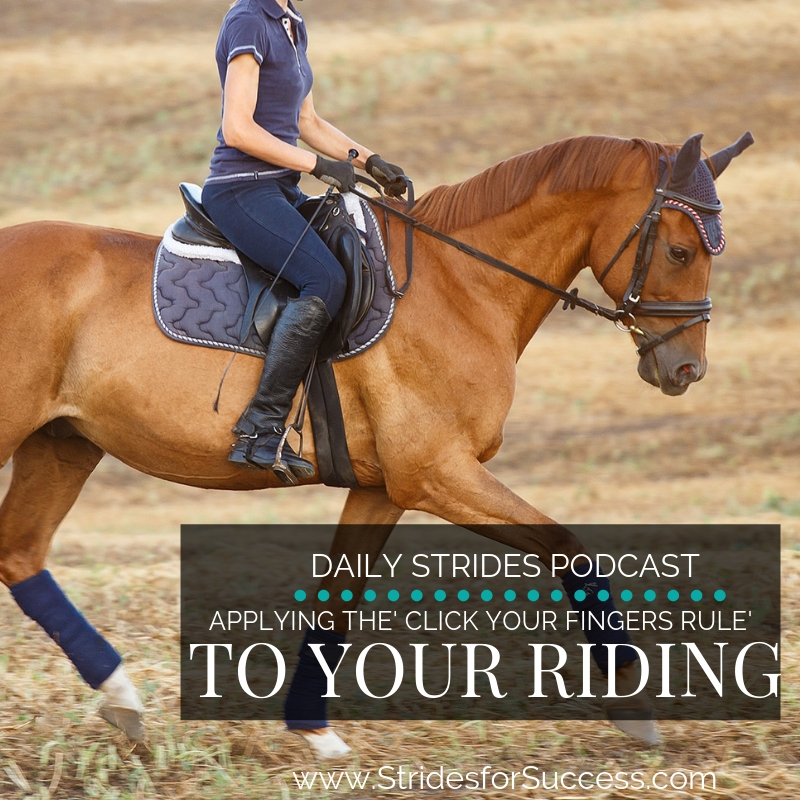
What this episode is all about & how it can help you:-
- Use this simple ‘rule’ in your day-to-day riding
- Know ‘when’ to apply this rule in your riding
- Begin to take responsibilities for your own balance in the saddle
- Make the necessary transition in your riding, from passenger to rider
Imagine if there was something you could actively ‘do’ every moment you’re in the saddle that would almost guarantee that you’re in the ‘right place at the right time’.. There is. And it involves abiding by a non written ‘rule’ regarding your position.
This episode of the Daily Strides Podcast is all about that rule and how you can use it, beginning today, in your riding. Your position is so important
What is the ‘Rule’
Well, imagine we (you and I) were in the arena together. You are travelling along on your horse, whether that be in walk, trot or canter. In fact, you could even be jumping, halfway through a transition – it makes no difference what you are doing. So, there you are, riding along and then I apply this ‘rule’ to you and your riding…
I ‘click my fingers’ and make your horse vanish. Yes, disappear into thin air from underneath you. Gone. The question you have to ask yourself is: “would I land on my feet?”.
Now, obviously this is not going to happen. I’m good, but I’m not that good! However by imagining the horse is suddenly not there, the questions becomes ‘where and how would you land?’.
If the answer is on your face or on your bum, it simply means that you are depending on your horse for balance, rather than being responsible for your own balance.
Who Are You Depending on For Balance?
When we start out riding initially, we do tend to rely a lot on our horses for balance. Thank goodness for all the school horses and ponies in the world with their endless patience! But in order for your riding to progress, this is something that you have to begin accepting responsibility for.
You are responsible for your own balance in the saddle. Applying this ‘rule’ to your riding will help you achieve that.
Relying on your own body, and therefore your own actions and responses, for balance will allow you to begin developing independent aids. Independent aids lead to clearer communication with your horse. They also lead to an independent seat. This ‘rule’ regarding your position will help you start working towards all of these things in your riding.
Applying the Rule
There is are two simple ‘checks’ you can do every time you’re in the saddle to begin effectively applying this rule to your position and your riding. The first to make sure that you are indeed sitting correctly in the saddle.
Use your seat bones for guidance. Are they directly underneath you, pointing straight down? Many upper body issues and lower leg issues are due to this basic principle being wrong or missing.
The second ‘check’ applies to the ‘lines’ to your position. Particularly the line that should run through your head, shoulder, hip and heel. If these elements of your body are aligned, you are usually ‘carrying’ yourself, which means that you are, for the most part, assuming responsibility for your own balance.
Being aware of the ‘rule’ will allow you to consistently reminding yourself to apply it to your riding, regardless of what you’re doing.
When Does This Rule Apply to Your Position?
The simple answer is ‘all the time’. Yes, really! Regardless if you are walking, trotting, cantering and even galloping. Or if you are riding on the flat, up or down hills. It is all the same. You are responsible for your own balance. Even when you are approaching a jump, starting the jumping effort, landing or a stride or two after the fence, this rule will apply.
If the horse was to vanish at any given point, anywhere in your ride, you should land on your feet.
Applying this to your Position & Riding
I’ve already mentioned checking your seat. Is it truly ‘underneath‘ you? From here, focus on keeping your legs under you at all times. A weak lower leg will swing, meaning that it can often be too far ahead of you, closer to your horses elbow or shoulder. Or too far behind you, closer to your horse’s flank area.
Neither of the above scenarios would result in you landing or standing on your own two feet if your horse was to vanish!
The final suggestion I have for consistently implementing this ‘rule’ in your riding regards your body when in the jumping position or two point seat. Think of your torso as being almost like a traditional weighing scales. Your shoulders are one end and your ‘bum’ is the other. Use your bum to keep your shoulders balanced.
A straight back is essential for this to happen, and this is where your core strength will really be essential to your overall balance.
Making the Transition in Your Riding
The ‘click your fingers rule’ is one that will, when applied consistently, change your riding. You will literally go from being dependent on your horse for support, to being able to actually support your horse when he needs it.
That is where you really begin to make the transition to being a true ‘rider’ in the saddle.
I am hosting a free, live online training for riders looking to begin making that transition in their riding; from passenger to rider. You can find out more and register HERE
Happy Riding
Lorna
Other Posts and Episodes that Relate to This Topic:-
